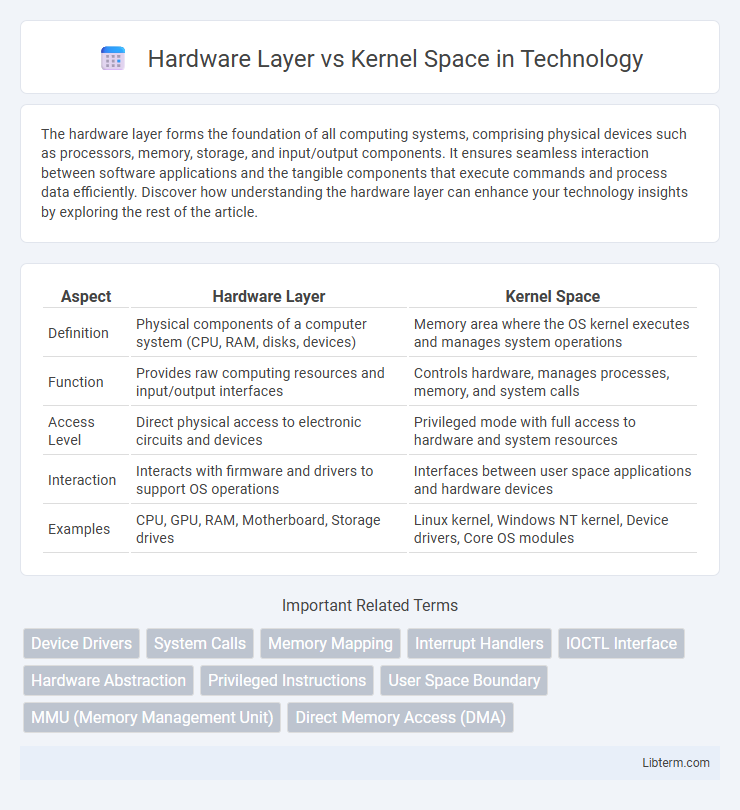The hardware layer forms the foundation of all computing systems, comprising physical devices such as processors, memory, storage, and input/output components. It ensures seamless interaction between software applications and the tangible components that execute commands and process data efficiently. Discover how understanding the hardware layer can enhance your technology insights by exploring the rest of the article.
Table of Comparison
| Aspect | Hardware Layer | Kernel Space |
|---|---|---|
| Definition | Physical components of a computer system (CPU, RAM, disks, devices) | Memory area where the OS kernel executes and manages system operations |
| Function | Provides raw computing resources and input/output interfaces | Controls hardware, manages processes, memory, and system calls |
| Access Level | Direct physical access to electronic circuits and devices | Privileged mode with full access to hardware and system resources |
| Interaction | Interacts with firmware and drivers to support OS operations | Interfaces between user space applications and hardware devices |
| Examples | CPU, GPU, RAM, Motherboard, Storage drives | Linux kernel, Windows NT kernel, Device drivers, Core OS modules |
Understanding the Hardware Layer
The hardware layer consists of physical components such as CPUs, memory chips, and input/output devices, forming the foundation for all computing processes. It directly interacts with electrical signals and mechanical operations, enabling data processing and communication within the system. Understanding the hardware layer is crucial for optimizing performance, troubleshooting, and developing low-level software that interfaces with devices at the kernel space level.
Defining Kernel Space
Kernel space is a protected memory area where the core of the operating system, including the kernel and device drivers, executes with high privilege and direct hardware access. This layer operates independently of user applications, enabling secure and efficient hardware management while preventing unauthorized interference. The hardware layer interacts with kernel space through controlled interfaces, ensuring stable communication between physical components and system processes.
Key Differences Between Hardware Layer and Kernel Space
The hardware layer consists of the physical components of a computer system, such as the CPU, memory, and peripheral devices, which operate independently of software. Kernel space is a protected memory area where the operating system kernel executes and manages system resources, providing an interface between hardware and user applications. Key differences include direct hardware access in the hardware layer versus mediated access through system calls in kernel space, and hardware being tangible components while kernel space is a software abstraction that ensures system stability and security.
Roles and Responsibilities of the Hardware Layer
The Hardware Layer manages physical components including CPUs, memory, and I/O devices, ensuring direct interaction and control over hardware resources. It handles low-level operations such as device communication, signal processing, and resource allocation, enabling efficient execution of instructions from the Kernel Space. This layer serves as the foundation for system stability, performance, and hardware abstraction, allowing higher-level software to operate without hardware-specific dependencies.
Functions of Kernel Space in Operating Systems
Kernel space in operating systems manages core functions such as process scheduling, memory management, and hardware abstraction, directly interacting with the hardware layer for efficient resource allocation. It provides a secure environment for executing privileged instructions, handling system calls, and managing device drivers that control hardware components. By isolating kernel space from user space, the operating system ensures stability, security, and controlled access to hardware resources.
Interaction Between Hardware Layer and Kernel Space
The hardware layer consists of physical components such as CPUs, memory modules, and I/O devices that execute low-level operations and generate interrupts. Kernel space acts as an intermediary managing direct communication between hardware and software, handling device drivers, memory management, and system calls to maintain control and security. This interaction ensures efficient hardware resource allocation and seamless execution of processes by translating hardware signals into software-readable operations.
Security Considerations in Hardware Layer vs Kernel Space
The Hardware Layer provides a foundational security boundary by isolating critical components such as the CPU, memory, and I/O devices, reducing attack surfaces through physical and firmware-level protections. Kernel Space controls access to hardware and system resources while enforcing privilege separation and memory protection mechanisms, which help prevent unauthorized code execution and privilege escalation. Hardware-based security features like Trusted Platform Modules (TPM) and secure boot complement kernel-level security policies to create a multi-layered defense against attacks targeting both software vulnerabilities and hardware exploits.
Performance Impact: Hardware Layer vs Kernel Space
Hardware Layer operates directly with physical devices, enabling faster data processing and lower latency compared to Kernel Space, which manages system resources through software abstractions and hardware drivers. Performance impact is significant as Hardware Layer interactions bypass kernel overhead, reducing context switches and system call delays typically encountered in Kernel Space operations. Efficient hardware communication optimizes throughput and responsiveness, crucial for real-time applications and high-performance computing environments.
Examples of Hardware Layer and Kernel Space Components
The Hardware Layer includes physical components such as CPUs, RAM, hard drives, and network interface cards that provide the foundation for computer operations. Kernel Space contains critical software components like device drivers, memory management, process scheduling, and system call handlers that directly interact with the hardware. Examples of Kernel Space components include the Linux kernel, Windows NT kernel, and macOS XNU kernel, which manage hardware resources and provide essential system services.
Future Trends in Hardware and Kernel Architecture
Future trends in hardware and kernel architecture emphasize tighter integration between hardware components and kernel space to enhance system performance and security. Advances such as heterogeneous computing, hardware-assisted virtualization, and specialized accelerators like AI chips demand kernel architectures to evolve for optimized resource management and low-latency communication. Emerging designs focus on scalable microkernel frameworks and hardware-enforced isolation to address complexity, improve fault tolerance, and support real-time processing in next-generation computing environments.
Hardware Layer Infographic

 libterm.com
libterm.com